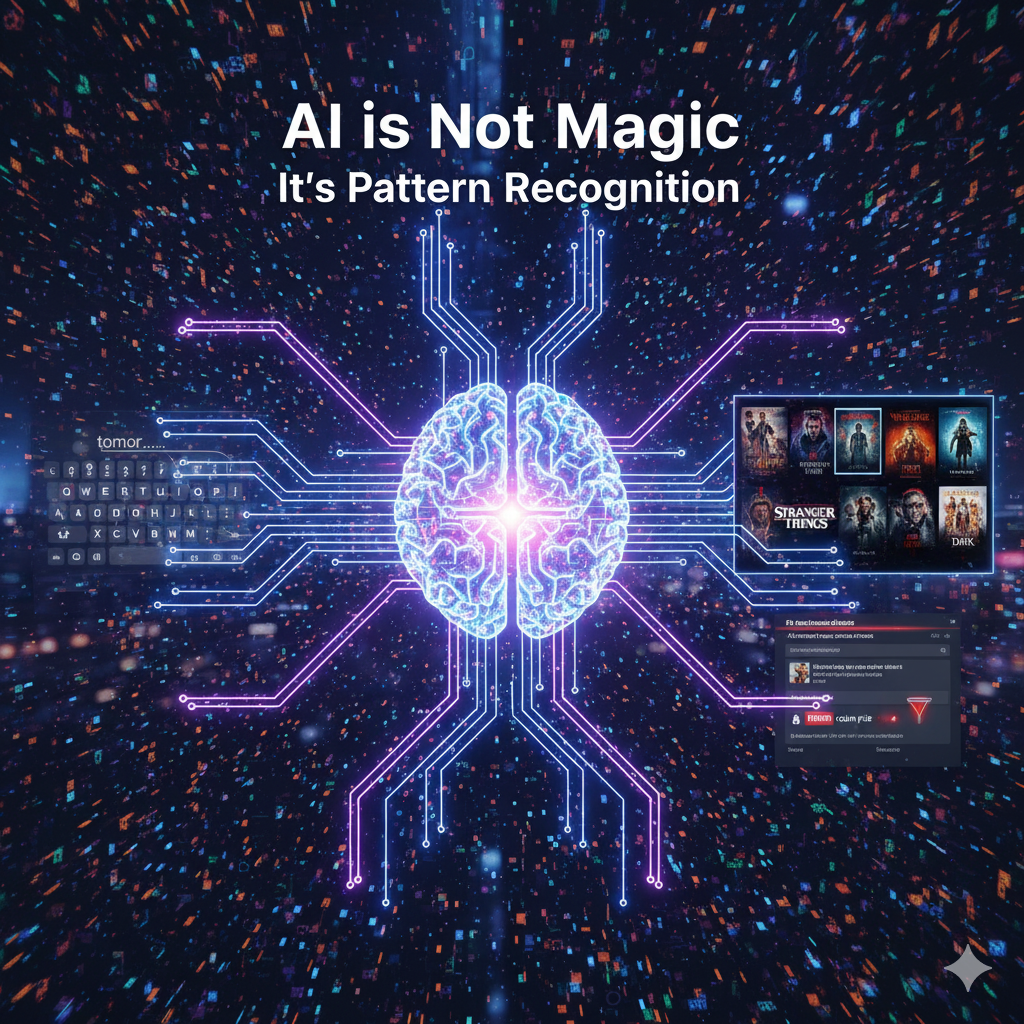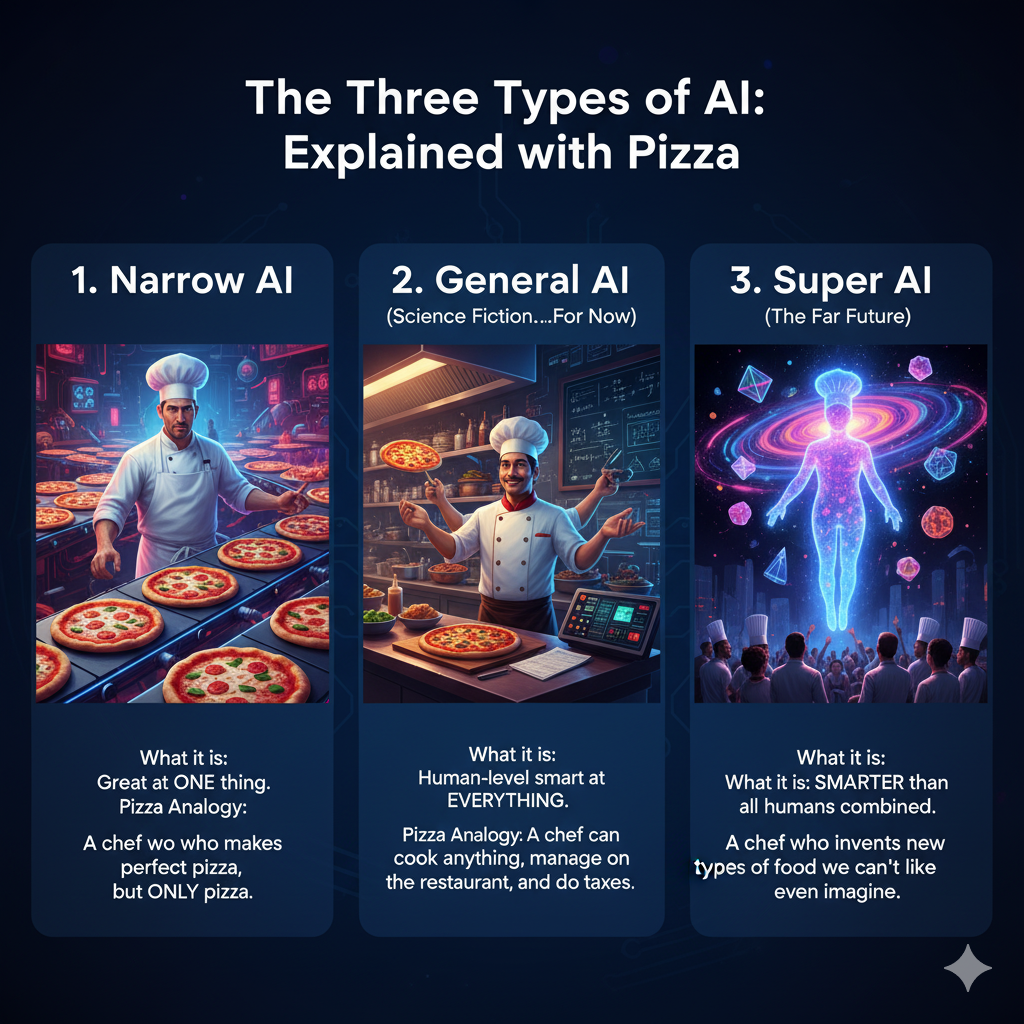AI is Not Magic - It's Pattern Recognition

Your phone just predicted what you wanted to watch next.
TikTok knew you'd love that cat video before you saw it. Spotify's playlist understands your mood better than your friends do.
That's not magic - that's AI recognizing patterns from millions of examples. Let me show you exactly how it works.
📱The TikTok Algorithm Story
When TikTok recommends videos, it considers:
- ✓What videos you watch completely (don't skip)
- ✓What you like, comment on, and share
- ✓What time of day you're watching
- ✓Which creators you follow
- ✓How quickly you scroll past content
This is pattern recognition in action - the foundation of all AI systems.
What AI Really Is (In Simple Terms)
AI is a pattern-finding machine. That's it.
No consciousness, no feelings, no actual "thinking" - just incredibly good pattern recognition.
📚 Learn More: This explanation aligns with how researchers atGoogle AI andOpenAIdescribe modern AI systems. For the technical foundation, check outDeep Learning by Goodfellow et al. (Chapter 5 covers machine learning basics).
Real AI Examples You Use Daily
1. TikTok's "For You" Page
How it works: AI recognizes your viewing patterns and finds similar content that other users with your tastes enjoyed
2. Spotify's Discover Weekly
How it works: AI analyzes what millions of users with similar music taste enjoyed that you haven't heard yet
3. Fortnite/Minecraft Matchmaking
How it works: AI recognizes your playing patterns and finds opponents who will give you a challenging but fair game
4. 2025 AI Models for Homework Help
How it works: AI recognizes patterns in millions of examples and adjusts explanation complexity based on your request
The Three Types of AI (Explained with Pizza)

🎓 Academic Context: This classification comes from AI research pioneered by AI researchers andNIST standards. For deeper understanding, see Stanford'sAI Index Report 2024.
1. Narrow AI (What We Have Now)
What it is: AI that's really good at ONE thing
Calculator analogy: Perfect at math but can't tell you a joke
Real examples:
- • TikTok algorithm that recommends videos but can't do homework
- • Spotify that finds music but can't understand your feelings
- • Face filters that add effects but don't know who you are
- • Game AI that plays perfectly but can't learn new games
2. General AI (Science Fiction... For Now)
What it is: AI as smart as humans at everything
Your brain analogy: Can learn math, understand emotions, create art, and make friends
Reality check:
- • None exist yet (despite what movies show)
- • Experts disagree: maybe 10 years, maybe 100+ years
- • Current AI is getting closer but still has limits
3. Super AI (The Far Future)
What it is: AI smarter than all humans combined
Einstein analogy: Like having Einstein working 24/7 on solving humanity's biggest problems
Reality: Pure speculation at this point
Busting AI Myths
Myth: "AI Will Take All Creative Jobs"
Reality: AI tools are like calculators for creativity - they help, but humans still need to guide them. Most artists and writers use AI as an assistant, not a replacement.
Myth: "AI Thinks Like Humans"
Reality: AI is pattern matching, not thinking. It doesn't understand meaning, have feelings, or consciousness. It's more like a super-powered autocomplete than a brain.
Myth: "AI Always Gives Correct Answers"
Reality: AI makes mistakes all the time! It can "hallucinate" facts, misunderstand questions, and give wrong answers. Always double-check important information.
Myth: "AI Knows Everything About You"
Reality: AI only knows what you give it. TikTok learns from what you watch, ChatGPT only knows your conversation history. Your privacy depends on what you share.
📰AI in the News (2024-2025)
GPT-5, Claude 4.5, Gemini 2.5, and Opus 4.1 are changing how we learn and create. Explore our complete LLMs you can run locally guide.
Source: OpenAI Blog,Anthropic Updates
Personalized learning help from Claude 4.5 and GPT-5 available 24/7
Research: U.S. Department of Education
Gemini 2.5 analyzes photos and videos to help with homework projects
Technical details: Multimodal AI Research
Now you can try on AI-generated outfits and effects
Platform: TikTok Developer Portal
Build entire games with AI assistance - no coding needed!
Announcement: Roblox Creator Hub
Try This: Pattern Spotting Challenge
5-Minute AI Pattern Detective:
See how AI recognizes patterns in your daily life!
📱 TikTok Algorithm Test
- • Open TikTok and note your first 5 videos
- • Like or comment on 2-3 videos about one topic
- • Watch 5 more videos - notice the pattern?
- • AI learned your interest in seconds!
🎵 Spotify Discovery Test
- • Play 3-4 songs you really like
- • Skip any songs you don't like immediately
- • Check your "Discover Weekly" tomorrow
- • AI found similar songs based on your patterns!
🤖 2025 AI Model Test
- • Try ChatGPT, Claude 4.5, or Gemini 2.5
- • Ask: "Explain photosynthesis like I'm 13"
- • Then ask: "Now explain it like I'm a scientist"
- • Notice how each AI adapts complexity differently
- • GPT-5 excels at science, Claude 4.5 at clear explanations
- • That's advanced pattern recognition in action!
Cool discovery: AI recognized your patterns almost immediately!
Frequently Asked Questions
What is AI in simple terms for beginners?
AI is pattern recognition software that finds patterns in millions of examples. It's not magic or consciousness - just math that recognizes patterns, like how your brain recognizes a friend's face among thousands.
How does the TikTok algorithm work for teens?
TikTok's AI tracks what videos you watch completely, what you like/comment/share, what time of day you watch, and how quickly you scroll. It then finds similar content that other users with your tastes enjoyed. This is pattern recognition in action.
What's the difference between Narrow AI and General AI?
Narrow AI (what we have now) is really good at ONE specific task, like TikTok recommendations or Spotify playlists. General AI (science fiction for now) would be as smart as humans at everything - learning, creating art, understanding emotions, etc.
Is AI taking over creative jobs like artists and writers?
No. AI tools are like calculators for creativity - they help and assist, but humans still need to guide them. Most artists and writers use AI as an assistant for brainstorming or tedious tasks, not as replacement for creativity.
How can I try AI pattern recognition myself?
Try these experiments: 1) On TikTok, like a few videos about one topic and watch how the algorithm adapts, 2) Use ChatGPT or Claude 4.5 and ask the same question in different ways to see how they respond, 3) Play around with Spotify's Discover Weekly to see how it finds music you'll like based on your patterns.
🧠Quick Quiz: Test Your AI Knowledge!
Question 1: Your TikTok feed learns your preferences in...
Question 2: AI is basically...
👨🏫For Parents & Teachers
📚 Perfect for: Starting conversations about digital literacy and AI safety
🎯 Learning outcomes: Understanding AI through apps teens already use
💡 Discussion topics: Privacy, screen time, and responsible AI use
⏱️ Time needed: 12 minutes + optional experiments
This chapter helps teens understand AI concepts through familiar apps, making abstract ideas concrete and relatable.
📚 Author & Educational Resources
About This Chapter
Written by the Local AI Master educational team with expertise in making complex AI concepts accessible to beginners.
Last Updated: 2025-10-28
Reading Level: Middle School (Grades 6-8)
Prerequisites: None - Perfect for absolute beginners
Target Audience: Middle school students, high school students, beginners curious about AI
Learning Objectives
- •Understand AI as pattern recognition, not magic
- •Identify AI in daily applications (TikTok, Spotify, games)
- •Differentiate between Narrow, General, and Super AI
- •Recognize common AI myths and misconceptions
- •Experience AI pattern recognition through hands-on experiments
📖 Authoritative Sources & Further Reading
Academic Resources:
Industry Sources:
🎓 Key Takeaways
- ✓AI is pattern recognition - not magic, but math that finds patterns
- ✓You use AI daily - TikTok, Spotify, games, homework helpers all use AI
- ✓2025 AI models are amazing - GPT-5, Claude 4.5, Gemini 2.5 each have unique strengths
- ✓Narrow AI is all we have - each AI does one thing really well
- ✓AI learns from examples - millions of patterns help it make predictions
- ✓AI isn't perfect - it makes mistakes and needs human guidance
- ✓Privacy matters - AI only knows what you share with it
How Does AI Actually Learn? 🐕
Next: Discover how AI trains itself like teaching a puppy - with hands-on experiments you can try right now!